Discover 35 hidden attractions, cool sights, and unusual things to do in Calgary (Canada). Don't miss out on these must-see attractions: TELUS Spark Science Centre, Calgary Tower, and Calgary Zoo. Also, be sure to include Heritage Park in your itinerary.
Below, you can find the list of the most amazing places you should visit in Calgary (Alberta).
Table of Contents
TELUS Spark Science Centre
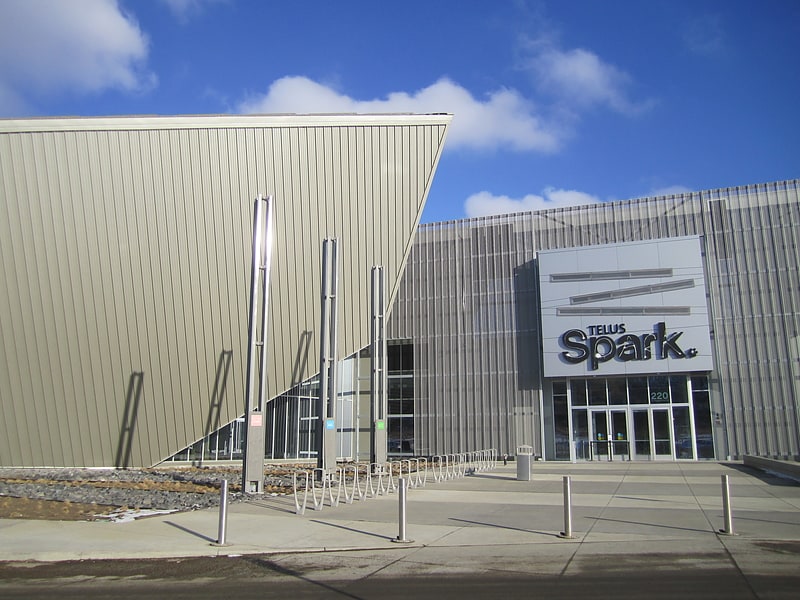
Museum in Calgary, Alberta. TELUS Spark Science Centre is a science museum with interactive exhibits, multimedia presentations and educational demonstrations in Calgary, Alberta, Canada. There are more than 430,000 visitors annually, including over 82,000 students.
The science museum was established in 1987 as the Calgary Science Centre. The science centre was later re-branded Telus World of Science – Calgary in 2005. In 2011, the science centre moved locations from the former Centennial Planetarium to the Nose Creek Valley. The science centre was re-branded as Telus Spark during the move.[1]
Address: 220 St Georges Dr NE, T2E 5T2 Calgary (Northeast Calgary)
Calgary Tower
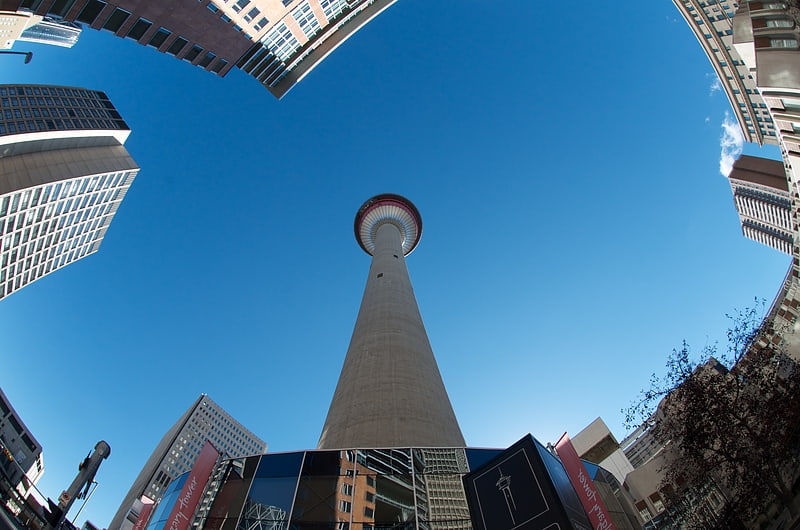
Tower in Calgary, Alberta. The Calgary Tower is a 190.8-meter free standing observation tower in the downtown core of Calgary, Alberta, Canada. Originally called the Husky Tower, it was conceived as a joint venture between Marathon Realty Company Limited and Husky Oil as part of an urban renewal plan and to celebrate Canada's centennial of 1967. The tower was built at a cost of CA$3,500,000 and weighs approximately 10,884 tonnes, of which 60% is below ground. It opened to the public on June 30, 1968 as the tallest structure in Calgary, and the tallest in Canada outside Toronto. It was renamed the Calgary Tower in 1971.
The building was a founding member of the World Federation of Great Towers.[2]
Address: Calgary, 101 9th Avenue SW, Calgary, Alberta, T2P 1J9
Calgary Zoo
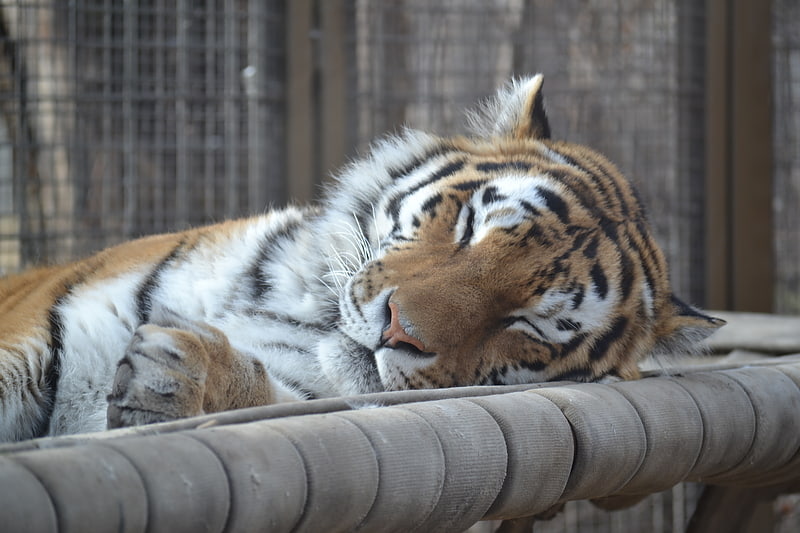
Zoo in Calgary, Alberta. The Calgary Zoo is located in Bridgeland, Calgary, Alberta, Canada, just east of the city's downtown and adjacent to the Inglewood and East Village neighborhoods. It is accessible via Calgary's C-Train light rail system, by car via Memorial Drive, and by bicycle and footpath via the Bow River pathway. A large portion of the zoo is located on St. George's Island in the Bow River.
The zoo is operated by the Calgary Zoological Society, an independent not-for-profit organization that is Alberta's oldest registered charity. The AZA, WAZA, and CAZA accredited zoo was among the first in Canada to be accredited by all three associations. It is home to over 1,000 animals, excluding individual fish and insects, and 272 different species. The 120-acre zoo is organized by into seven distinct zones: Destination Africa, Canadian Wilds, Penguin Plunge, Dorothy Harvie Botanical Gardens and ENMAX Conservatory, TransAlta Rainforest, Eurasia, and Prehistoric Park. The zoo is open every day except for Christmas Day.
As Canada's most visited zoo, Calgary Zoo was in 2015 recognized by TripAdvisor with its Travellers' Choice Award. The zoo has also received international recognition as one of the top zoos in the world for conservation research. In 2013, the Association of Zoos and Aquariums said "the Calgary Zoo sets itself apart as one of the top zoos in the world." In 2015 the zoo was named one of the top three most respected organizations in Alberta and one of Alberta's 10 most beloved brands.[3]
Address: 1300 Zoo Rd NE, T2E 7V6 Calgary (Southeast Calgary)
Heritage Park
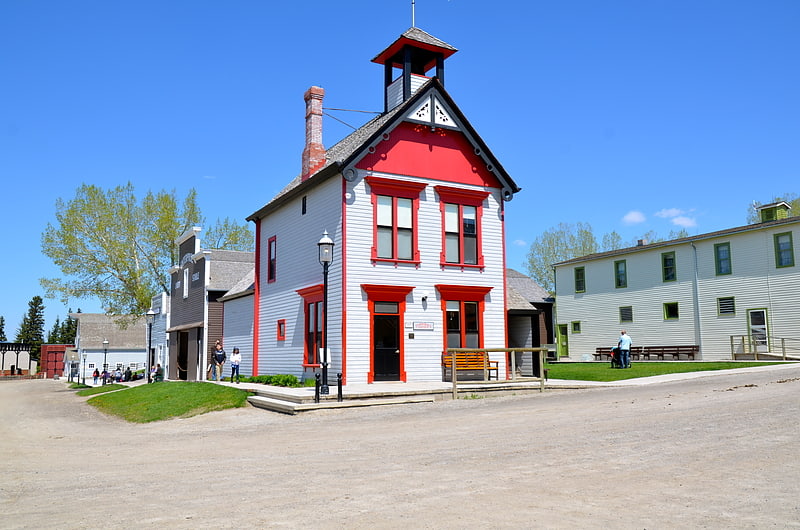
Museum in Calgary, Alberta. Heritage Park Historical Village is a historical park in Calgary, Alberta, Canada, on 127 acres of parkland on the banks of the Glenmore Reservoir, along the city's southwestern edge. As Canada's second largest living history museum, it is one of the city's most visited tourist attractions. Exhibits span western Canadian history from the 1860s to the 1950s. Many of the buildings are historical and were transported to the park to be placed on display. Others are re-creations of actual buildings. Most of the structures are furnished and decorated with genuine artifacts. Staff dress in historic costume, and antique automobiles and horse-drawn vehicles service the site. Calgary Transit provides regular shuttle service from Heritage C-Train station. The park opened on July 1, 1964.
The Park has two operating seasons: the Historical Village is open from May to October; Gasoline Alley Museum is open year-round.[4]
Address: 1900 Heritage Drive S.W, Calgary (Southwest Calgary)
Canada's Sports Hall of Fame
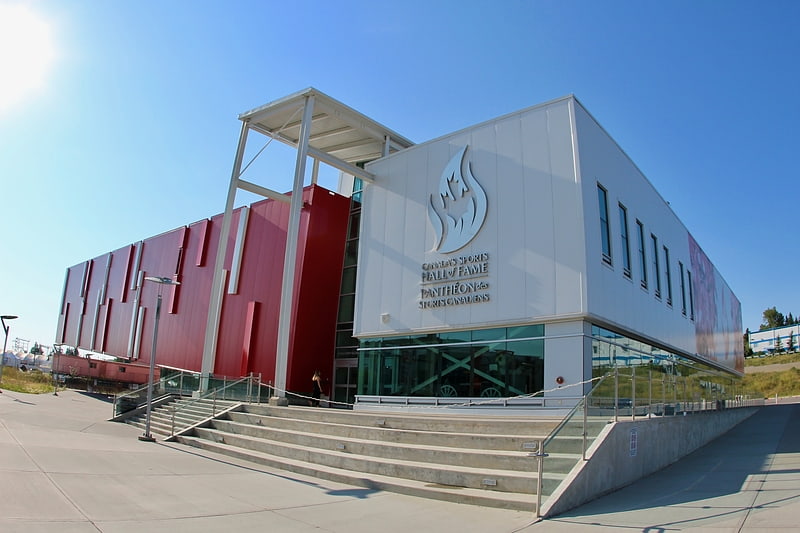
Canada's Sports Hall of Fame is a Canadian sports hall of fame and museum in Calgary, Alberta, Canada. Dedicated to the history of sports in Canada, it serves as a hall of fame and museum for accomplished Canadian athletes, and sports builders and officials.
Established in 1955, the organization inducted its first class of hall of famers, and opened a museum to the public that year. The museum was originally located at Exhibition Place in Toronto. In 1957, the hall of fame moved to another facility at Exhibition Place, sharing the space with the Hockey Hall of Fame. A new building to house the two halls of fame was later built at Exhibition Place in 1961. The two halls of fame continued to share facilities until 1993, when the Hockey Hall of Fame moved to a different location. Canada's Sports Hall of Fame became the building's sole occupant until it was closed in 2006 to make way for BMO Field. The organization continued to induct honourees to its hall of fame, although a new facility to house its museum was not completed until 2011. The 4,100 square metres (44,000 sq ft) facility was opened at Canada Olympic Park in Calgary, and houses the organization's offices and hall of fame museum.
As of 2019, there were 673 inductees into Canada's Sports Hall of Fame, categorized either as athletes, or as builders of the sport. Inductees are nominated by the Canadian public, though are ultimately selected by the organization's selection committee. In addition to inductions into its hall of fame, the organization has also conferred awards for accomplishments in sport, and in the larger community.[5]
Address: 169 Canada Olympic Rd SW, T3B 6B7 Calgary (Southwest Calgary)
Prince's Island Park

Park in Calgary, Alberta. Prince's Island Park is an urban park in the city of Calgary, Alberta, Canada. It is developed on an island on the Bow River, immediately north of downtown Calgary.
It was named after Peter Anthony Prince, the founder of the Eau Claire Lumber Mill. The park was built on land donated in 1947 to the city by the Prince family. It is often incorrectly referred to as "Princess Island Park". The park is open from 5 a.m. until 11 p.m. every regular day.
The island has a surface of 20 hectares and is linked by three bridges to Eau Claire and downtown Calgary and a north bridge to Memorial Drive and the community of Crescent Heights. It is part of the pathway and hiking trail system lining both sides of the Bow River. The southern arm of the river has been landscaped, while the eastern end of the island re-creates a wetland environment. Canada geese and mallard ducks are common birds found in the park.[6]
Address: 100 Prince's Island Park SW, T2J 7A7 Calgary
Canada Olympic Park
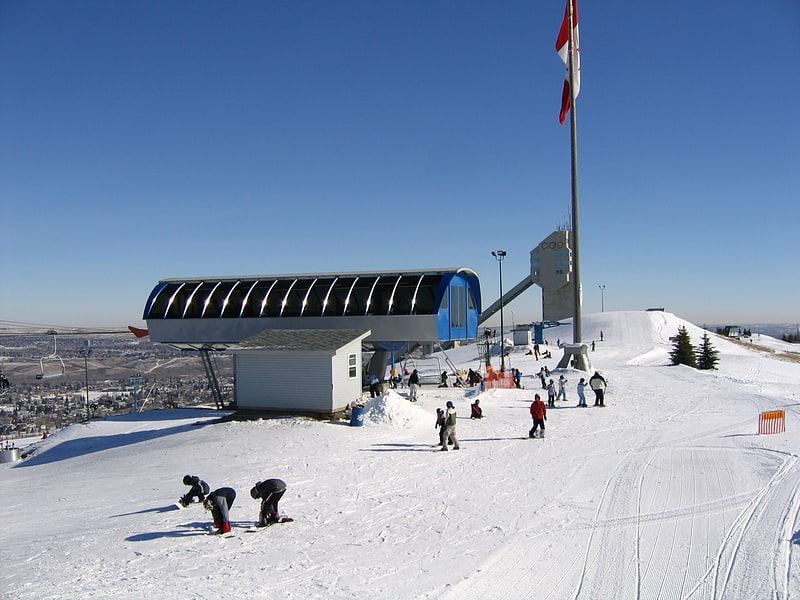
Ski area. The Calgary Olympic Development Association, operating as WinSport, is a non-profit organization based in Calgary, Alberta, Canada whose mandate is to provide training and development to Canada's Olympic athletes, and to maintain the facilities built for the 1988 Winter Olympics. The organization was founded in 1956 to bring the Olympics to Calgary, succeeding in its fourth attempt. WinSport has been credited with dramatically improving Canada's performance at the Olympics, as medal totals have increased at each subsequent Winter Games held since 1988, to a peak of 26 in the 2010 Winter Olympics.[7]
Address: 88 Canada Olympic Rd SW, T3B 5R5 Calgary (Southwest Calgary)
Fort Calgary
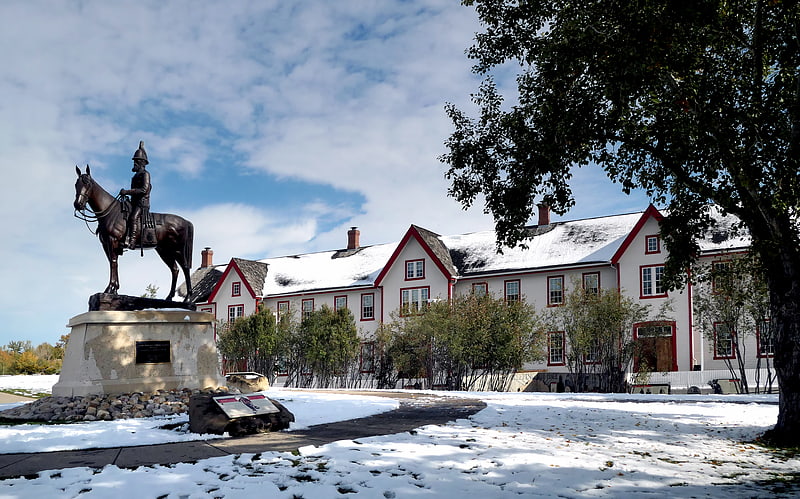
Museum in Calgary, Alberta. Fort Calgary was a North-West Mounted Police outpost at the confluence of the Bow and Elbow rivers in present day Calgary, Alberta, Canada. Initially named Fort Brisebois, after the outpost's first commander, the outpost was renamed Fort Calgary in June 1876.
The outpost was built in 1875 as a part of the force's larger effort to curtail American rum and whisky runners in the region, and to create 'good relations' with the Indigenous peoples of the territory. The fort was designated as a "district post" in 1882, resulting in the fort's expansion. The North-West Mounted Police (NWMP) continued to use the fort until 1914, when the site was sold to Grand Trunk Pacific Railway. The fort was demolished to make way for a rail terminal.
The site was later purchased by the municipal government of Calgary in 1973, with work on an interpretive centre taking place in 1977. The site was reopened as a historic site and museum in 1978, with the museum initially documenting the NWMP and its role in the area. The scope of the museum was later reoriented in 1995 to focus on the local history of Calgary. During the 1990s, reconstructions of several buildings that once stood at Fort Calgary took place at the historic site.[8]
Address: 750 9 Ave SE, T2G 5E1 Calgary
Suncor Energy Centre
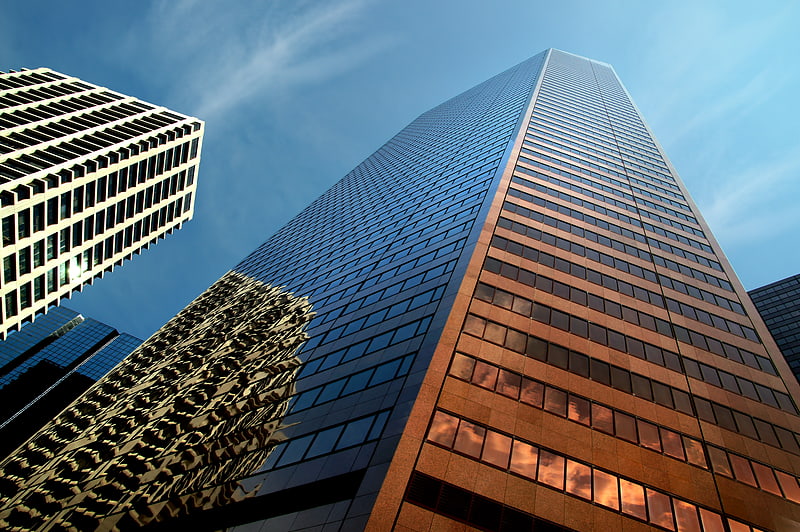
Building complex in Calgary, Alberta. The Suncor Energy Centre, formerly the Petro-Canada Centre, is a 181,000-square-metre project composed of two granite and reflective glass-clad office towers of 32 floors and 52 floors, situated in the office core of downtown Calgary, Alberta. The Council on Tall Buildings and Urban Habitat lists the west tower, as the 19th tallest building in Canada and the fourth tallest skyscraper outside of Toronto. The west tower overtook the Calgary Tower as the tallest free-standing structure in Calgary from its completion in 1984, until being surpassed by the neighbouring Bow in 2010. The office towers encompass 158,000 m2 of rentable office space with the complex also containing 23,000 m2 of retail and underground parking area. A glass-enclosed walkway provides shelter and easy access to the surrounding buildings.
The building was often called Red Square in its early years, a derisive reference to its primary occupant Petro-Canada, which was a federal Crown Corporation created under Prime Minister Pierre Trudeau's National Energy Program. Following the completion of the complex in 1984, one writer for the Calgary Herald described the buildings as "a twin-towered, $200-million monument to socialism", and later Premier Peter Lougheed would blame Petro-Canada and the two towers for the collapse of the Calgary real-estate boom, in part by flooding the market. Petro-Canada was privatized in 1991 under the Brian Mulroney government and acquired in 2009 by the complex's current namesake, Suncor Energy, which continues to operate the company as a subsidiary.[9]
Address: 150 6 Ave SW #210w, T2P 3Y6 Calgary
Centennial Planetarium
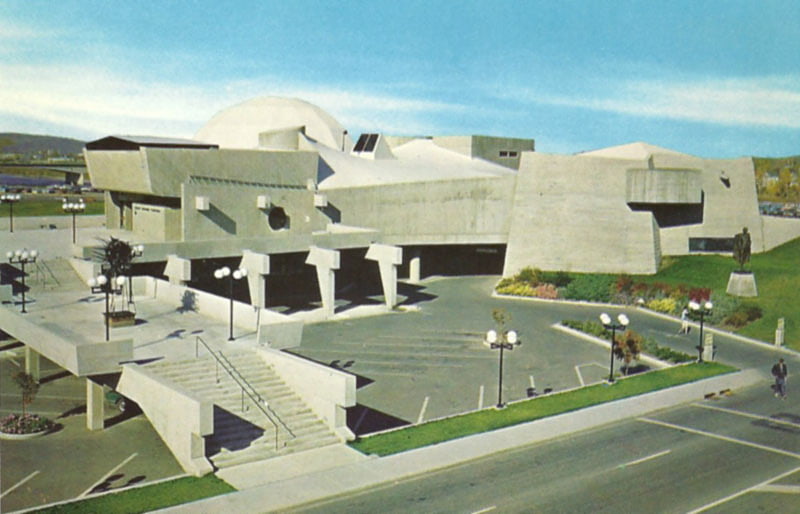
Planetarium in Calgary, Alberta. The Centennial Planetarium was a planetarium located at 701 11 Street SW in Calgary, Alberta. Designed by Calgary architectural firm McMillan Long and Associates and opened in 1967 for the Canadian Centennial, it is one of Calgary's best examples of Brutalist architecture. As of 2019, the building housed Contemporary Calgary, a public art gallery.[10]
Address: 701 11 Street SW, Calgary
Bankers Hall
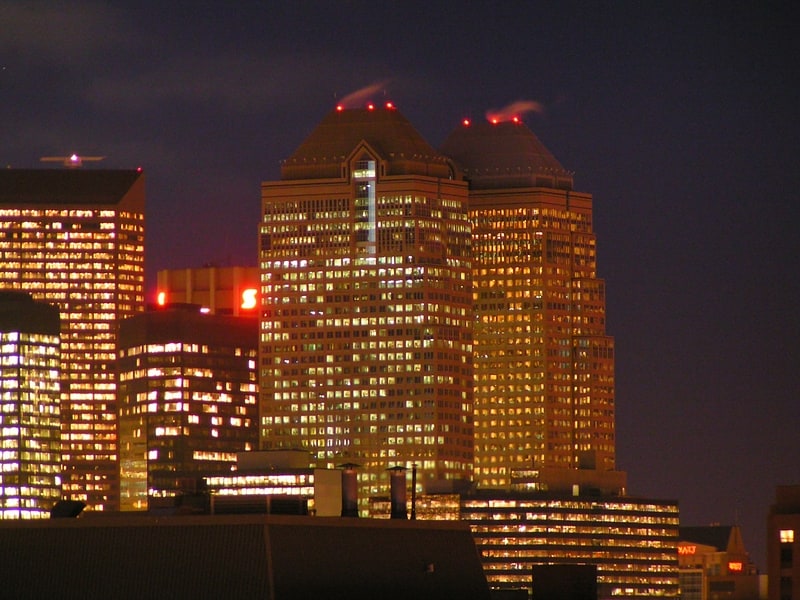
Building complex. Bankers Hall is a building complex located in downtown Calgary, Alberta, which includes twin 52-storey office towers, designed by the architectural firm Cohos Evamy in postmodern architectural style.
The first building, known as Bankers Hall East, is located at 855 2nd Street SW and was completed in 1989. It was followed in 2000 by Bankers Hall West, at 888 3rd Street SW. After its completion, they became the tallest twin buildings in Canada.
Both buildings contain four-level podiums with an upscale retail gallery connected to the Plus 15 skywalk network. The Core Shopping Centre, the largest shopping complex in downtown Calgary, is directly connected via Plus 15. The northeast corner of the complex incorporates the historic Hollinsworth Building, whose intricate terra cotta facade has been fully restored.
The distinctive crowns of the buildings are intended to resemble cowboy hats when viewed from afar; Bankers Hall West is topped by a gold roof structure while the East building's crown is in silver. A white cowboy hat has long been an iconic symbol of Calgary, being portrayed on the city's flag, and presented as gifts to foreign dignitaries by the civic government at "white hatting ceremonies".
For tenants and people who work in and around Bankers Hall, there is also a fitness centre called Bankers Hall Club. Bankers Hall Club occupies the old space of the Bankers Hall Five movie theater which was open from 1990 to 2001.[11]
Address: 315 8 Ave SW, T2P 4K1 Calgary
Dale Hodges Park
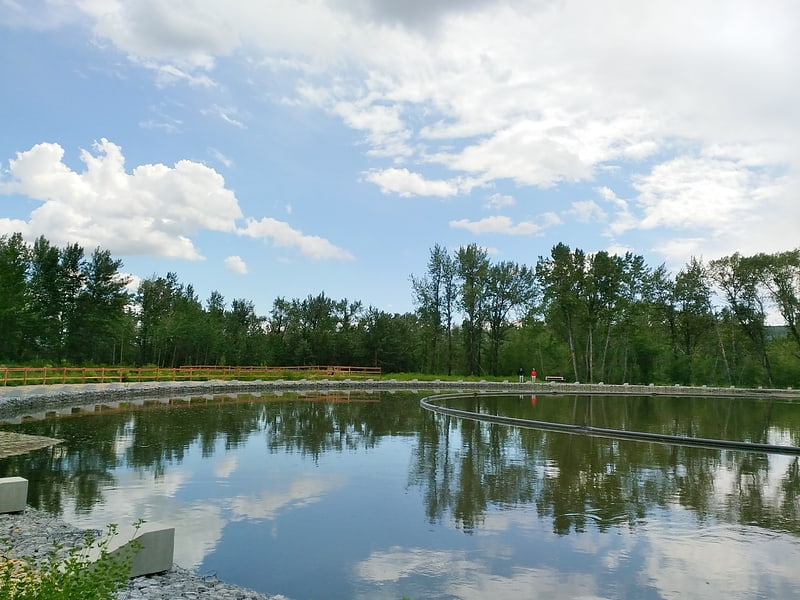
Park in Calgary, Alberta. Dale Hodges Park is a 40.4686 hectares natural environment urban park, stormwater treatment, and public artwork in northwest Calgary, Alberta—an expansion of Bowmont Park— where stormwater from eight northwest upstream residential communities flows slowly through "water structures and landforms" inspired by "natural river morphology as well as hydrologic and sedimentation processes" that serve as filters. The park, which is connected to the regional pathway, has a boardwalk, cycling and walking trails, the Nautilus Pond, a polishing marsh, a wet meadow, man-made streams, vantage points of the Bow River, and wildlife habitat.
The $26.8 million project to "restore native riparian habitats" of the contaminated Klippert gravel pit, then known as the East Bowmont Natural Environment Park (NEP), began in 2010. It was completed in the fall of 2018 and officially opened to the public on June 26, 2019, following a ceremony in which Mayor Naheed Nenshi dedicated the park to Dale Hodges, in recognition of his many contributions to Calgary as the longest service member of council. Alderman Hodges was active for 30 years—from 1983 to 2013—"protecting and creating Calgary's green spaces".[12]
Peace Bridge
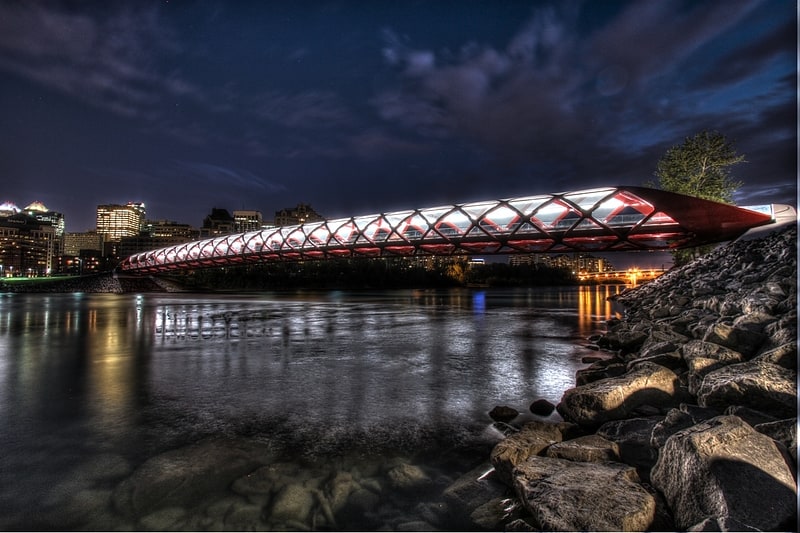
Pedestrian bridge in Calgary, Alberta. Peace Bridge is a bridge that accommodates people walking and cycling across the Bow River in Calgary, Alberta, Canada. The bridge, designed by Spanish architect Santiago Calatrava, opened for use on March 24, 2012. It has the popular nickname "Finger Trap Bridge" for its visual similarity to the finger trap puzzle.
The bridge was built by The City of Calgary to connect the southern Bow River pathway and Downtown Calgary with the northern Bow River pathway and the community of Sunnyside. This connection was designed to accommodate the increasing number of people commuting to and from work and those utilizing Calgary's pathways. The bridge is reportedly used by 6000 people a day and has ranked among the top 10 architectural projects in 2012 and among the top 10 public spaces of 2012.[13]
Address: Memorial Drive NW, Calgary
Centre Street Bridge

Bridge in Calgary, Alberta. The Centre Street Bridge is a historic bridge in Calgary, Alberta, crossing the Bow River, along Centre Street. The lower deck connects Riverfront Avenue in Chinatown with Memorial Drive, while the upper elevated deck crosses Memorial Drive as well, reaching into the community of Crescent Heights.
Centre Street Bridge is the central point of the quadrant system of the city.[14]
Address: Centre St. N., Calgary
Glenbow Museum

Artworks and local history on display. The Glenbow Museum is an art and history regional museum in the city of Calgary, Alberta, Canada. The museum focuses on Western Canadian history and culture, including Indigenous perspectives. The Glenbow was established as a private non-profit foundation in 1955 by lawyer, businessman and philanthropist Eric Lafferty Harvie with materials from his personal collection.
The museum moved to its current facility in downtown Calgary in 1976, and is funded by the governments of Calgary, Alberta and Canada, private donors, as well as an endowment provided by Harvie. In 2019, the Glenbow had a total of 148,668 visitors. The museum closed temporarily for renovations in 2021, and will re-open in 2024.
Admission to the museum is free as of February 2022, due to a $25 million donation by the Shaw Family Foundation. $15 million of the donation will be placed in an endowment fund for admissions, and $10 million is earmarked for the new JR Shaw Institute for Canadian Art.[15]
Address: 130 9 Ave SE, T2G 0P3 Calgary
Olympic Plaza
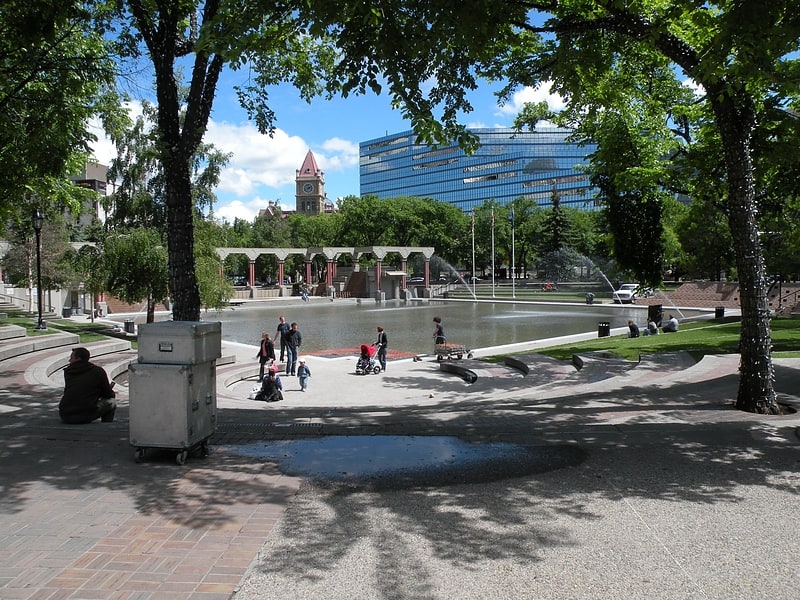
City park in Calgary, Alberta. The Olympic Plaza is an urban park and gathering place in downtown Calgary, Alberta, Canada. Located around Macleod Trail and 7th Avenue S. it was created as the venue for the medal ceremonies at the 1988 Winter Olympics. In 2004, over 30,000 people packed the plaza to celebrate the Calgary Flames run to the 2004 Stanley Cup Finals.
Olympic Plaza serves as a meeting place, and an outdoor event area, hosting concerts and festivals. In the winter, it is used as a public ice skating area. The plaza is accessible by Calgary's CTrain system at the City Hall station.[16]
Address: 7th Ave. SE and Macleod Trail SE, T2N 1J9 Calgary
Glenmore Reservoir
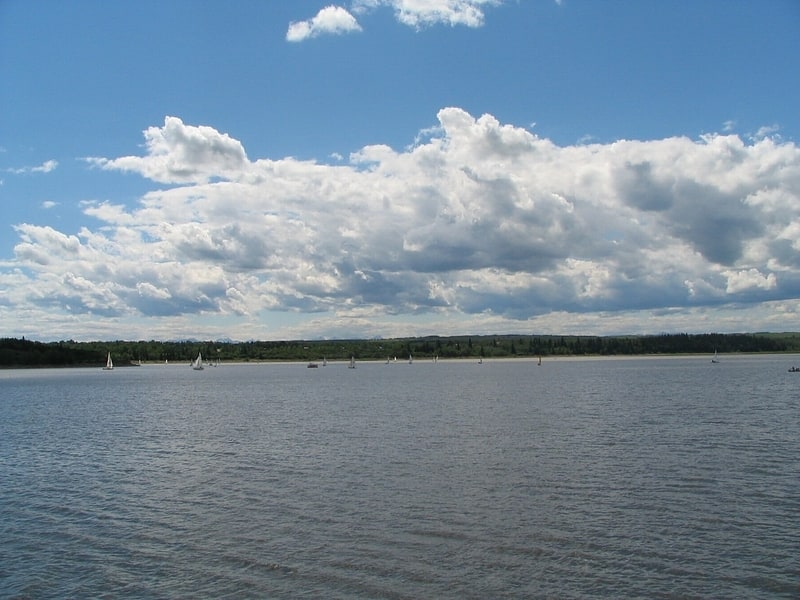
Reservoir in Alberta, Canada. The Glenmore Reservoir is a large reservoir on the Elbow River in the southwest quadrant of Calgary, Alberta. The Glenmore Dam is a concrete gravity dam on the Elbow River built to control the reservoir. The Glenmore Reservoir is a primary source of drinking water to the city of Calgary. Built in 1932, with a cost of $3.8 million, the dam controls the downstream flow of the Elbow River, thus allowing the city to develop property near the river's banks with less risk of flooding.
The reservoir’s perimeter features a scenic, uninterrupted 16km multi-use pathway/pedestrian and cycling trail along the water’s edge, connecting popular city destinations such as the Heritage Marina beach, Heritage Park Historical Village, South Glenmore Park, Glenmore Sailing Club, Weaselhead Flats Natural Environment Park, North Glenmore Park, Calgary Canoe Club, Calgary Rowing Club, and the Earl Grey Golf Club.
The reservoir has a water mirror of 3.84 km2 (1.48 sq mi) and a drainage basin of 1,210 km2 (470 sq mi). In 2014, the City of Calgary announced plans to rehabilitate and upgrade the Glenmore Dam at a cost of $81 million.
The Reservoir is bordered to the west by the Tsuut’ina Nation reserve, to the north by the communities of Lakeview and North Glenmore, to the east by the neighbourhood Eagle Ridge (which sits on the peninsula alongside Heritage Park), and to the south by the communities of Oakridge, Palliser, and Pump Hill.[17]
Devonian Gardens
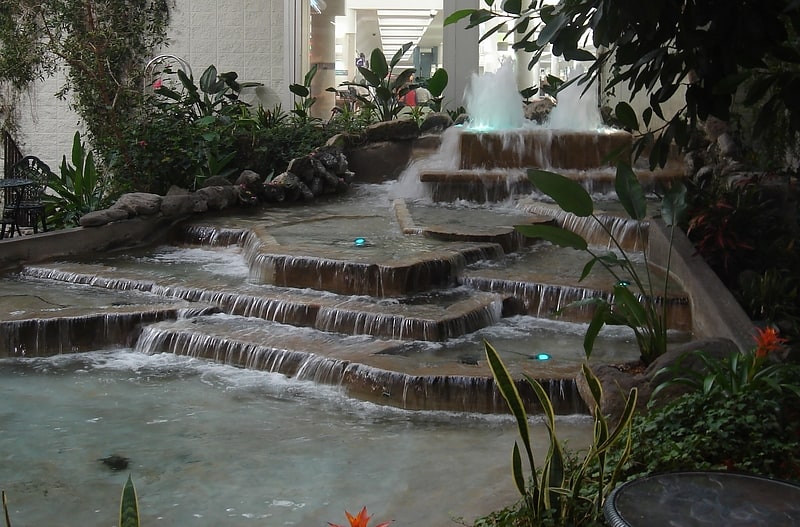
Park in Calgary, Alberta. Devonian Gardens is a large indoor park and botanical garden located in the downtown core of Calgary, Alberta, Canada. In 2012 a major $37-million renovation was completed.
Located on the Stephen Avenue pedestrian mall (8 Avenue SW) between 2 Street SW and 3 Street SW, the park is completely enclosed with glass and covers 2.5 acres (10,000 m2) (one full city block) on the top floor of The Core Shopping Centre (formerly TD Square). It is maintained by The City of Calgary Parks.
The gardens include a living wall, koi ponds, fountains, a children's play area, and over 550 trees, as well as meeting/function space for special events. A full-service restaurant is also planned.[18]
Address: 317 7 Ave SW, T6G 2E1 Calgary
Stephen Avenue Walk
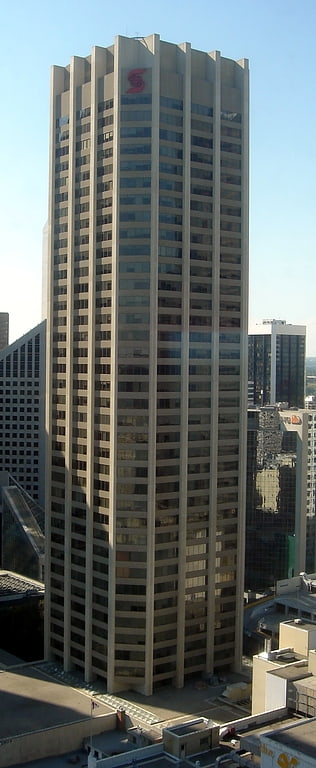
Building in Calgary, Alberta. Stephen Avenue Place, formerly Scotia Centre is an office and retail hub in downtown Calgary, Alberta, Canada. Located at 700 2nd Street SW, it stands at 155 metres or 41-storeys tall and was the tallest building in Calgary at the time of its completion.
Formerly known as the Scotia Centre, the building was purchased by Slate Asset Management in March 2018 and is currently undergoing a redevelopment project that will involve significant renovations to the three story retail podium and building amenities. The project will feature three restaurants run by Concorde Group and Oliver & Bonacini.
Stephen Avenue Place is named for George Stephen, the first Baron Mount Stephen, who was the visionary, businessman and financier behind the creation of the Canadian Pacific Railway.[19]
Address: 8 Ave S between 1 St SE and 4 St SW, Calgary
Calgary Alberta Temple
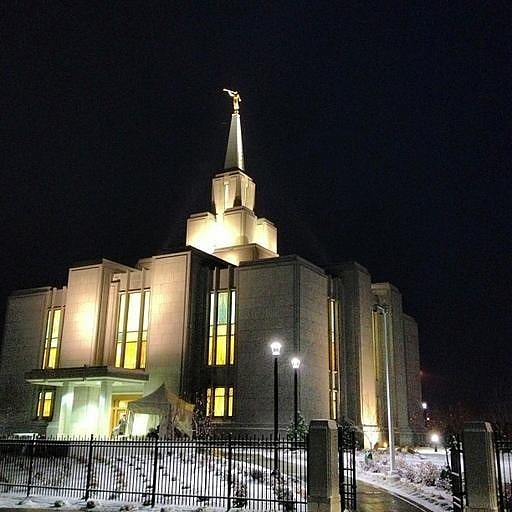
Church of jesus christ of latter-day saints in Calgary, Alberta. The Calgary Alberta Temple is the 140th temple of The Church of Jesus Christ of Latter-day Saints and the third built in Alberta. The first, previously known as the Alberta Temple, was built in Cardston in 1923. The Edmonton Alberta Temple opened in 1999.[20]
Address: 9802 Rocky Ridge Rd NW, T3G 5J7 Calgary (Northwest Calgary)
McMahon Stadium

Stadium in Calgary, Alberta. McMahon Stadium is a Canadian football stadium in Calgary, Alberta. The stadium is owned by the University of Calgary and operated by the McMahon Stadium Society.
The stadium is between the downtown core and the University of Calgary, north of 16 Avenue NW between Crowchild Trail and University Drive. It is within walking distance of the Banff Trail C-Train station.
It is the home venue for the University of Calgary Dinos, Calgary Colts of the Canadian Junior Football League, Calgary Gators and Calgary Wolfpack of the Alberta Football League, and the Calgary Stampeders of the Canadian Football League, who played at Mewata Stadium from 1935 to 1959. The stadium also was the open-air venue (as an ice rink) for the National Hockey League's 2011 Heritage Classic match between the Calgary Flames and the Montreal Canadiens.
The stadium was also the location of the 1988 Winter Olympics opening and closing ceremonies, serving as the Olympic Stadium.[21]
Address: 1817 Crowchild Trail NW, T2M 4R6 Calgary (Northwest Calgary)
Riley Park
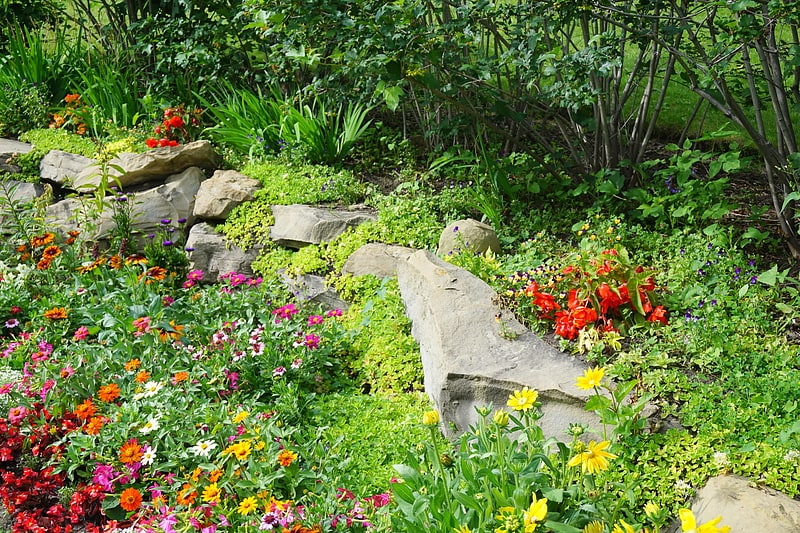
Park in Calgary, Alberta. Riley Park is an urban park in Calgary, Alberta, Canada. It is located in the neighbourhood of Hillhurst, bounded by 8th Ave. NW, 10th St. NW, 5th Ave. NW and 12th St. NW. The park plays is host to Calgary's Cricket Leagues and Calgary Concert Band holds free concerts in the park during summer. Amenities include a wading pool and playground.[22]
Address: 800 12 St NW, T2N 1W3 Calgary (Northwest Calgary)
Baitun Nur Mosque

Mosque in Calgary, Alberta. Baitun Nur is an Ahmadiyya mosque in Calgary, Alberta. Baitun Nur is the largest mosque in Canada.[23]
Address: 4353 54 Ave NE, Calgary (Northeast Calgary)
The Military Museums
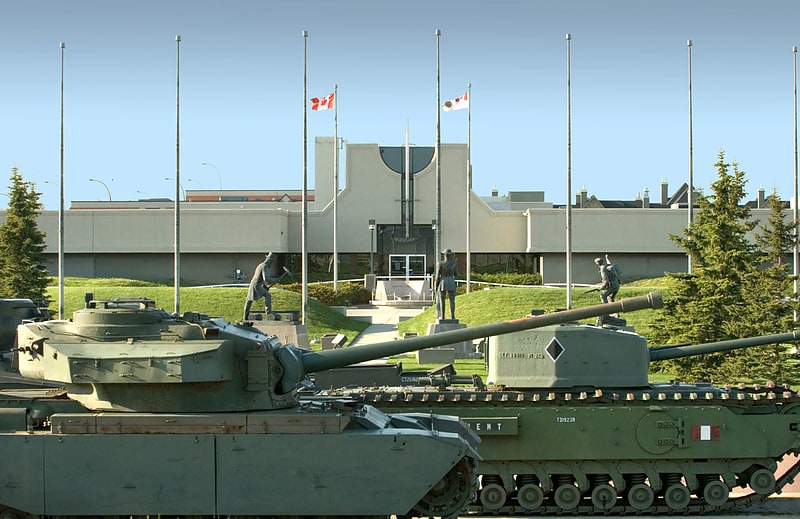
Museum in Calgary, Alberta. The Military Museums is a reorganization of the former Museum of the Regiments in Calgary, Alberta, announced by Sophie, Countess of Wessex, on June 3, 2006. The new museum comprises the former Museum of the Regiments as well as the relocated Naval Museum of Alberta and an Air Force Wing consisting of artifacts being acquired.[24]
Address: 4520 Crowchild Trail SW, T2T 5J4 Calgary (Southwest Calgary)
Nose Hill Park
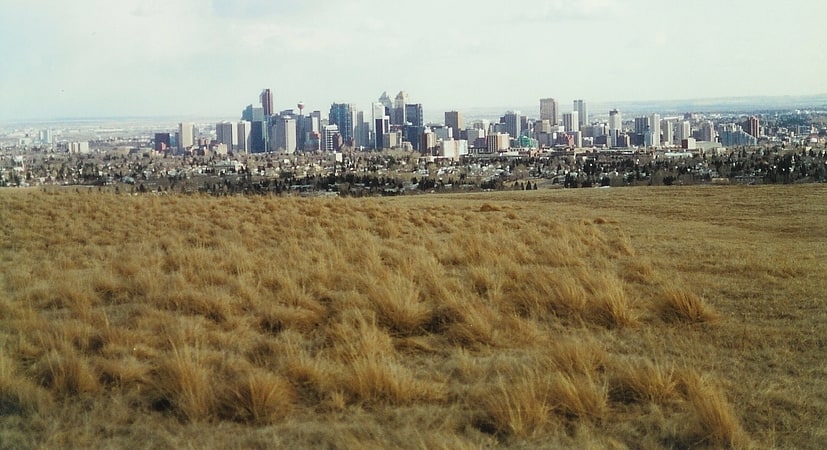
Park in Calgary, Alberta. Nose Hill Park is a natural park in the northwest quadrant of Calgary, Alberta which covers over 11 km2. It is the fourth-largest urban park in Canada, and one of the largest urban parks in North America. It is a municipal park, unlike Fish Creek, which is a provincial park. It was created in 1980.[25]
Address: 5620 14 St NW, T2N 4C9 Calgary (Northwest Calgary)
Chinese Cultural Centre
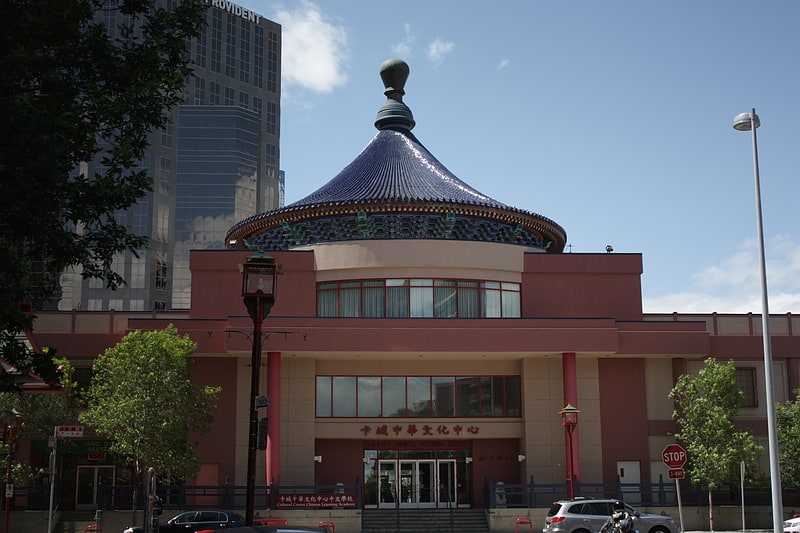
Building in Calgary, Alberta. The Chinese Cultural Centre is a building in Calgary, Alberta, Canada. It is located on the north-eastern side of downtown and was completed in September 1992.
The centre piece of the complex is the Dr. Henry Fok Cultural Hall, a building modeled after the Hall of Prayers of the Temple of Heaven in Beijing. The 70 foot (21 m) high ceiling is decorated with 561 dragons and 40 phoenixes. It is supported by 4 columns with gold ornamentation representing each season. The outer surface of the dome is covered in blue tiles imported from China and crafted by the same company that endowed the Temple of Heaven during the Ming Dynasty 600 years ago. They were installed in traditional Chinese layered fashion and consolidated with mortar.
The second level of the building contains classrooms and a library with books in Chinese and English (Orrin and Clara Christie Might Library). The main level hosts Dr. Henry Fok Cultural Hall, Henry G.D. Chow auditorium and a traditional Chinese medicine facility. There's also a restaurant and Chinese Artifacts Museum on the lower level.[26]
Address: 197 1 St SW, T2P 4M4 Calgary
Calgary City Hall
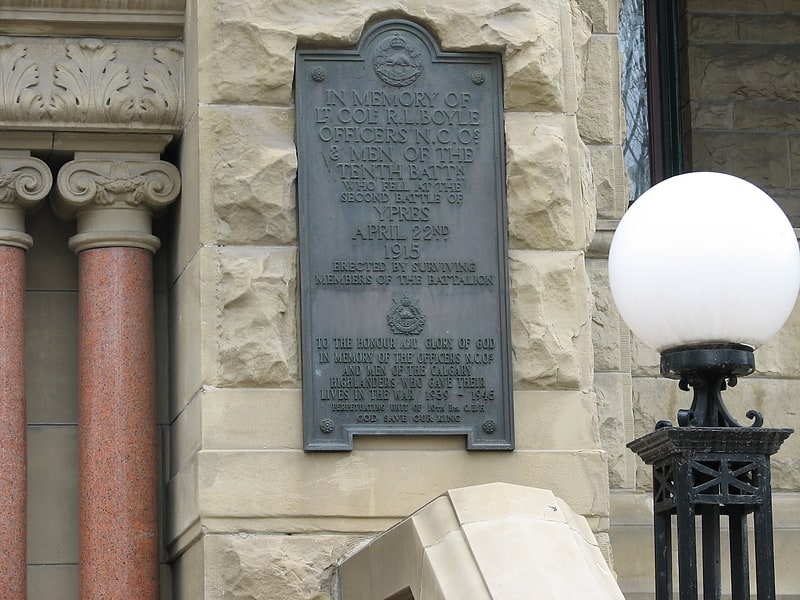
Building in Calgary, Alberta. Calgary City Hall, is the seat of government for Calgary City Council, located in the city's downtown core of Calgary, Alberta, Canada. The historic building completed in 1911 serves as the offices for Calgary City Council, consisting of the office of the Mayor, fourteen Councillors and municipal Clerk. Calgary City Hall originally housed the municipal council and portions of administration from its completion in 1911 until the construction of the Calgary Municipal Building adjacent to Old City Hall in 1985, which currently houses the offices of 2,000 civic administrators.
Calgary City Hall is designated a National Historic Sites of Canada, as well as a Provincial Historical Resource, and Municipal Historical Resource.[27]
Address: Calgary, 716 Macleod Trail SE, Calgary, AB T2G 5E6
Edworthy Park
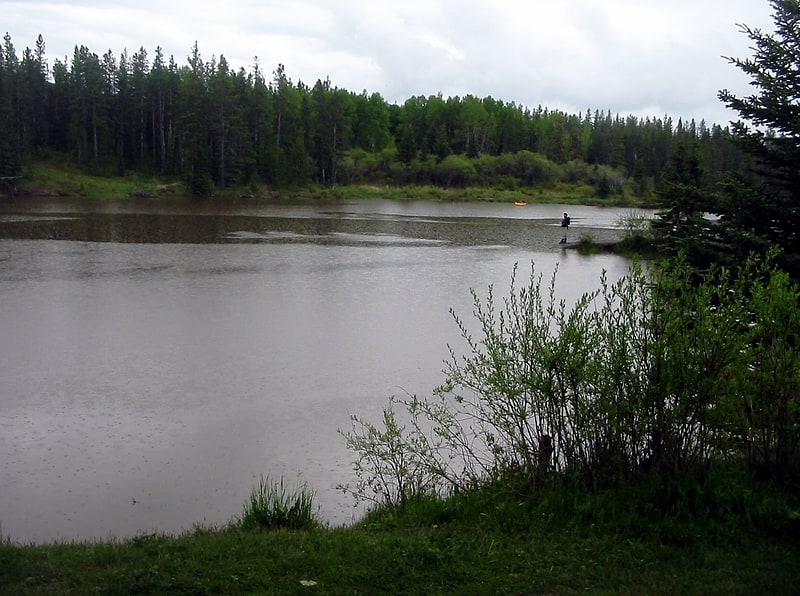
Park in Calgary, Alberta. Edworthy Park is a city park located in the Northwest section of Calgary along the south shore of the Bow River. The Canadian Pacific Railway crosses the length of the park. It was named after Thomas Edworthy, who emigrated to the Calgary area in 1883 from Devon, England.
The park has a surface of 1.27 square kilometres (0.49 sq mi), and contains over 5 kilometres (3.1 mi) of hiking and biking trails, part of the Bow River pathway.[28]
Eighth Avenue Place

Building complex in Calgary, Alberta. Eighth Avenue Place is a 1,850,000 sq ft twin-tower building complex located in downtown Calgary, Alberta, Canada. The complex includes a 49-storey 212 m East tower, 40-storey 177 m West office tower, and a three-storey indoor urban park.
The complex is housed on the site of the former Penny Lane Mall, originally intending to keep the historic name as "Penny Lane Towers", the project has since been renamed.[29]
Address: 525 8 Ave SW #210, T2P 1G1 Calgary
St. Mary's Cathedral

Cathedral in Calgary, Alberta. St. Mary's Cathedral in Calgary, Alberta, Canada is a Roman Catholic cathedral and the seat of the Diocese of Calgary. The building’s full name is The Cathedral of the Immaculate Conception of the Blessed Virgin Mary.[30]
Address: 219 18 Ave SW, T2S 0C2 Calgary (Southwest Calgary)
Cathedral Church of the Redeemer
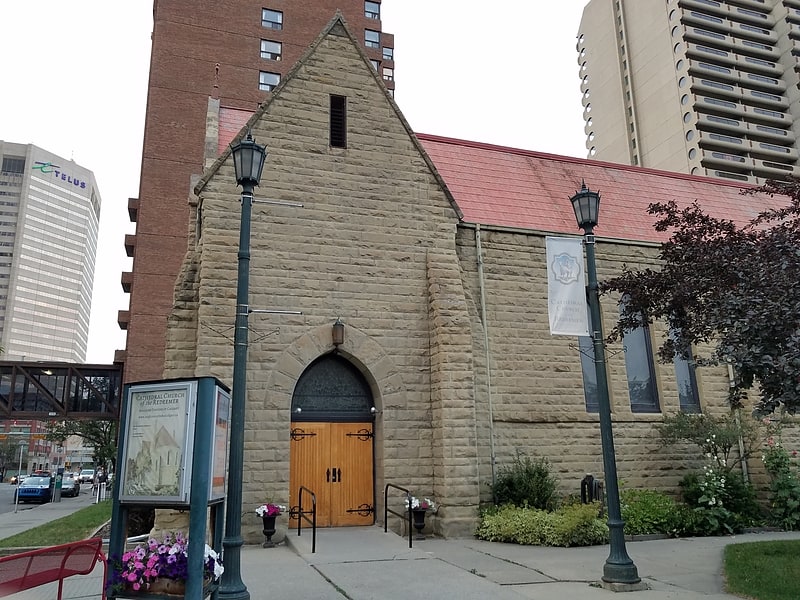
Anglican church in Calgary, Alberta. The Cathedral Church of the Redeemer is located in the downtown core of Calgary, Alberta, Canada. It is the seat of the Anglican Diocese of Calgary.[31]
Address: 604 - 1st St SE, Calgary
National Music Centre

Non-profit. The National Music Centre is a non-profit museum and performance venue located in Calgary, Alberta, Canada. The centre's permanent building, branded Studio Bell, is located at 850 4th Street S.E. in Downtown East Village.[32]
Address: 850 4 Street SE, T2G 1R1 Calgary
The Grand
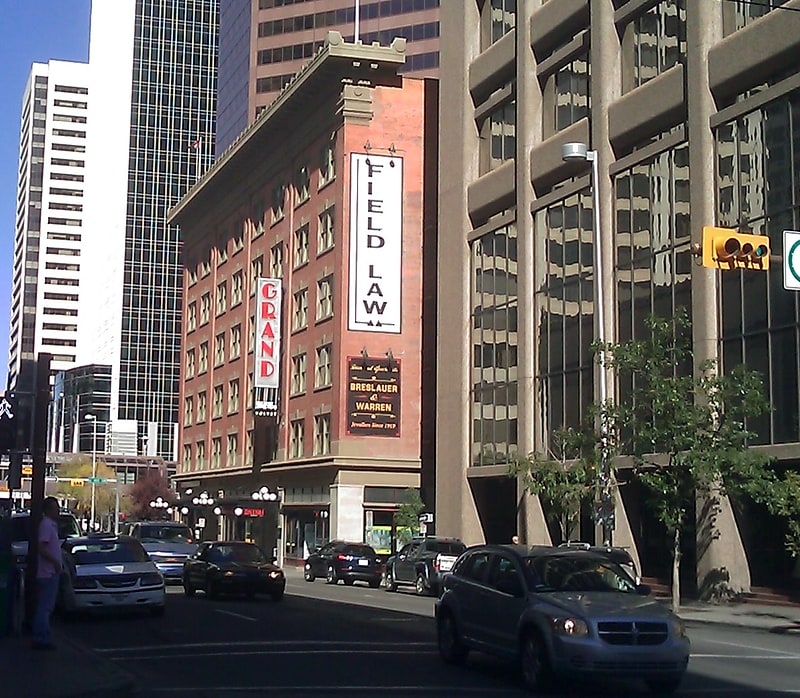
Theatre in Calgary, Alberta. The Grand, stylized as The GRAND, is the oldest theatre in the downtown core of Calgary, Alberta, Canada. In its current incarnation, it houses and operates the 436-seat Flanagan Theatre and a rehearsal space, the Studio.[33]
Address: 608 1 St SW, T2P 1M6 Calgary
Millennium Park
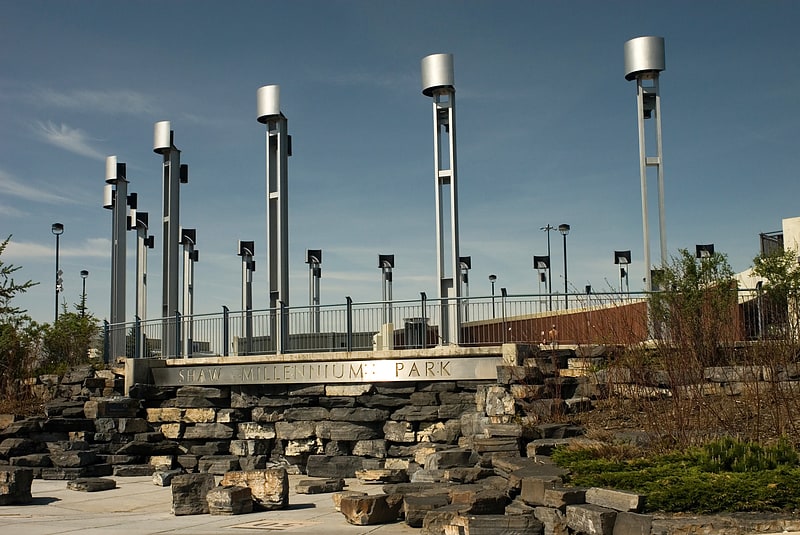
Millennium Park also known as Shaw Millennium Park is a skatepark in Calgary, Alberta, Canada, on the western end of downtown Calgary, on the site of the former Mewata Stadium adjacent to Mewata Armouries.
The 75,000 square feet (7,000 m2) skatepark was built in 2000, and was the largest park of its kind in Canada. The park is sponsored by Shaw Communications. The skatepark is maintained by the City of Calgary Recreation Department.
It consists of a street course with ledges, flatbars, stairs and transitions, an intermediate course with rails down stairs and banks, and an advanced course with cloverleaf bowl, street course and a large fullpipe.
The facility is also used to host events such as the Calgary International Reggae Festival.[34]
Address: 1220 9th Ave SW, T3C 0A1 Calgary
Fish Creek Provincial Park
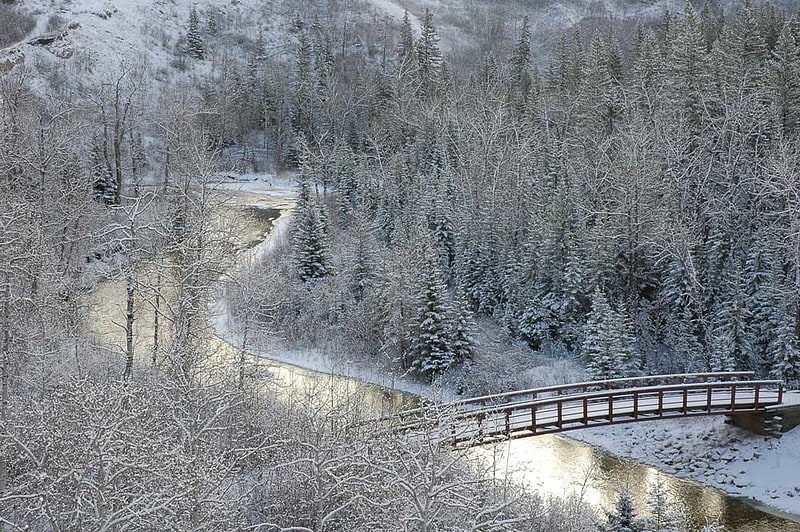
Provincial park in Calgary, Alberta. Fish Creek Park is an urban provincial park that preserves the valley of Fish Creek in the southern part of Calgary, Alberta, Canada. It is bordered on three sides by the city, and on the west by the territory of the Tsuu T’ina Nation, a First Nation.
Much of the park remains in a natural, forested state. Fish Creek flows throughout its length, joining the Bow River on the east side of the park, and there is an artificial lake that offers swimming. With more than 100 kilometres (62 mi) of paved and unpaved trails, the park is a popular area for hiking and biking, as well as for picnicking, swimming, fishing, and observing wildlife.
Fish Creek Park is the second-largest urban park in Canada after Rouge National Urban Park in the Greater Toronto Area, Ontario, and followed by Pippy Park in St. John's, Newfoundland and Labrador. It is also one of the largest urban parks in North America, stretching 19 km (12 mi) from east to west. With an area of 13.48 km2 (5.20 sq mi), it is more than three times the size of Vancouver's Stanley Park.[35]